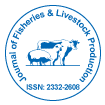Selective Breeding in Freshwater Fish: Techniques and Outcomes
Received Date: Dec 02, 2024 / Published Date: Dec 31, 2024
Abstract
Selective breeding in freshwater fish is a powerful tool for improving aquaculture productivity, enhancing disease resistance, and optimizing growth rates. This process involves the deliberate selection of parent fish with desirable traits to pass on to the next generation, resulting in offspring that exhibit improved performance in various traits such as size, feed conversion, and stress resistance. The techniques used in selective breeding include family selection, crossbreeding, and genomic selection, which leverage genetic tools to accelerate the improvement process. This paper explores the principles, methods, and outcomes of selective breeding in freshwater fish, with a focus on the genetic, environmental, and economic factors that influence breeding success. It examines the role of selective breeding in enhancing the sustainability and efficiency of freshwater fish farming, addressing key challenges such as disease susceptibility, environmental tolerance, and market demand for specific fish characteristics. While selective breeding has led to significant improvements in freshwater fish species, it also raises concerns about genetic diversity, inbreeding, and the potential for unintended ecological impacts. The paper highlights the need for balanced approaches that incorporate genetic management strategies and responsible breeding practices to ensure long-term sustainability.
Citation: Riga V (2024) Selective Breeding in Freshwater Fish: Techniques and Outcomes. J Fisheries Livest Prod 12: 608 Doi: 10.4172/2332-2608.1000608
Copyright: © 2024 Riga V. This is an open-access article distributed under the terms of the Creative Commons Attribution License, which permits unrestricted use, distribution, and reproduction in any medium, provided the original author and source are credited
Share This Article
Recommended Journals
Open Access Journals
Article Tools
Article Usage
- Total views: 391
- [From(publication date): 0-0 - Mar 29, 2025]
- Breakdown by view type
- HTML page views: 233
- PDF downloads: 158
